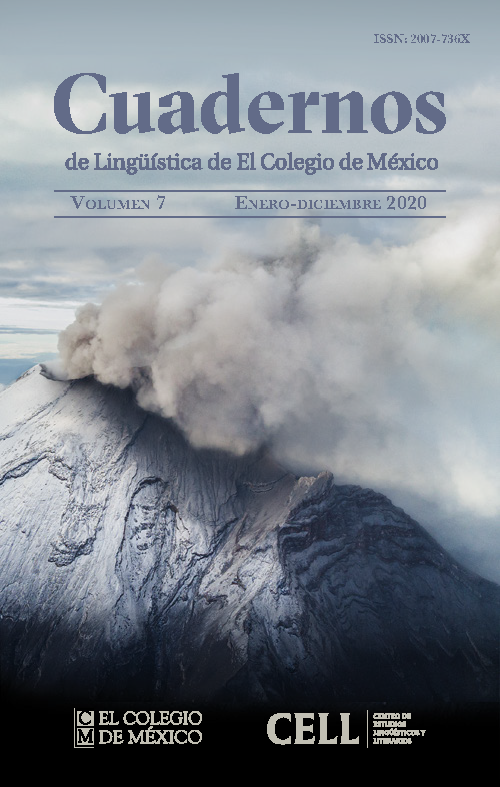Syntax of non-agreeing third person clitic formd in Teopantlan, Puebla (Mexico) Spanish
DOI:
https://doi.org/10.24201/clecm.v7i0.128Keywords:
syntax, clitic forms, under-represented Spanish dialect, clitic theoryAbstract
This paper is about the syntax of the third person object marker (OM) of an under-represented Spanish dialect spoken in Teopantlan, Puebla (Mexico). Even though this object marker has the familiar Spanish form of the third person singular masculine object clitic lo, the former shows a divergent behavior with respect to the pronominal clitics in other Spanish dialects: a proclitic tendency, an almost complete lack of a-markers for od in doubling contexts, lack of evidence of an agreement between the clitic-like form and the doubled DP and also a low or null interaction between the semantics of the doubled phrase and the object marker. In this paper I show some descriptive data of the Teopantlan dialect and also, I propose an analysis based on agree and lexical specifications of the little v head, that allows us to account for the above-mentioned behavior of this form that has not yet been considered in the literature for this or similar Spanish dialects.
Downloads
References
Abney, Steven. 1987. The English noun phrase in its sentential aspect. Cambridge: Massachusetts Institute of Technology. (Tesis doctoral).
Aissen, Judith. 2003. Differential object marking: iconocity vs. economy. Natural Language and Linguistic Theory 21(3). 435–483. doi: 10.2307/4048040
Anagnostopoulou, Elena. 2006. Clitic doubling. En Everaert, Martin & van Riemsdijk, Hendrik C. (eds.). The Blackwell Companion to Syntax. Wiley Online Library, 519–581. Oxford: Blackwell. doi: 10.1002/9780470996591.ch14
Belloro, Valeria. 2007. Spanish clitic doubling: A study of the syntax-pragmatics interface. Buffalo: State University of New York. (Tesis doctoral).
Brucart, José M. & Hernanz M. Lluïsa. 2015. Las posiciones sintácticas. En Gallego, Ángel (ed.). Perspectivas de sintaxis formal, 33-110. Madrid: Akal.
Borer, Hagit. 1983. Parametric syntax. Case studies in Semitic and Romance languages. Dordrecht: Foris. doi: 10.1017/S0022226700010963
Borer, Hagit. 2005. Structuring sense: In name only, vol. I. Oxford: Oxford University Press.
Camacho, José & Sánchez, Liliana. 2002. Explaining clitic variation in Spanish. En Amberber, Mengistu & Collins, Peter (eds.). Language universals and variation, 21–41. Norwood: Ablex.
Camacho, José; Paredes, Liliana & Sánchez, Liliana. 1995. The genitive clitic and the genitive construction in Andean Spanish. Probus 7(2). 133–147.
Company, Concepción & Flores, Rodrigo. 2014. La preposición a. En Company, Concepción. (dir.), Sintaxis histórica de la lengua española.
Tercera parte: Adverbios, preposiciones y conjunciones. Relaciones interoracionales, 1195–1340. México: Fondo de Cultura Económica & Universidad Nacional Autónoma de México.
Chomsky, Noam. 1995. The Minimalist Program. Cambridge, MA: The MIT Press.
Chomsky, Noam. 2000. Minimalist inquiries: The framework. En Martin, R.; Michaels, D. & Uriagereka, J. (eds.). Step by step. Essays onminimalist syntax in honor of Howard Lasnik, 89–155. Cambridge, MA: MIT Press.
Chomsky, Noam. 2001. Derivation by phase. En Kenstowicz, M. (ed.), Kenneth Hale. A life in language, 1–52. Cambridge, MA: MIT Press.
Escobar, Ana María. 1990. Los bilingües y el castellano en el Perú. Lima: Instituto de Estudios Peruanos.
Fernández–Soriano, Olga. 1999. El pronombre personal. Formas y distribuciones: Pronombres átonos y tónicos. En Bosque, Ignacio & Demonte, Violeta. Gramática descriptiva de la lengua española, (Sintaxis básica de las clases de palabras 1), 1209–1274. Madrid: Espasa Calpe.
Flores Nájera, Lucero. 2019. La gramática de la cláusula simple en el náhuatl de Tlaxcala. Ciudad de México: Centro de Investigaciones y Estudios Superiores en Antropología Social. (Tesis doctoral).
Gallego, Ángel J. 2008. Teoría del Caso y Sintaxis Minimista. Revista Española de Lingüística 38(2). 21–46.
Hale, Kenneth. 2003. On the significance of Eloise Jelinek’s pronominal argument hypothesis. En Carnie, Andrew; Harley, Heidi & Willie, MaryAnn (eds.). Formal approaches to function in grammar: In honor of Eloise Jelinek, 11–43. Ámsterdam: John Benjamins.
Harley, Heidi & Ritter, Elizabeth. 2002. Person and number in pronouns: A feature-geometric analysis. Language 78(3). 482–526.
Harris, James. 1996. The morphology of Spanish clitics. En Campos, Héctor & Kempchinsky, Paula (eds.), Evolution and revolution in linguistic theory: Essays in honor of Carlos Otero, 168–197. Washington: Georgetown University Press.
Haugen, Jason D. 2015. Configurationality in Classical Nahuatl. (Ponencia presentada en Workshop on Structure and Constituency in the Languages of the Americas, enero 23 (WSCLA 20). University of Arizona). Working papers in linguistics 43. 56-70.
Jaeggli, Osvaldo. 1982. Topics in Romance syntax (Studies in Generative Grammar 12). Dordrecht: Foris.
Jelinek, Eloise, 1984. Empty categories, case, and configurationality. Natural Language & Linguistic Theory 2(1). 39–76. doi: 10.2307/4047560
Kayne, Richard. 1975. French syntax: The transformational cycle. Cambridge: MIT Press.
Kayne, Richard. 1991. Romance clitics, verb movement, and PRO. Linguistic Inquiry 22(4). 647–686. doi: 10.2307/4178745
Langacker, Ronald. W. 1977. Studies in Uto-aztecan grammar, Volume I: An overview of Uto–Aztecan grammar. Arlington: The Summer Institute of Linguistics & The University of Texas.
Luján, Marta. 1987. Clitic-doubling in Andean Spanish and the theory of case absorption. En Morgan, Terrell A.; Lee, James F. & Vanpatten, Bill (eds.), Language and language use: Studies in Spanish, 109–121. Washington: University Press of America.
Mayer, Elisabeth. 2010. Syntactic variation of object arguments in Limeño Spanish contact varieties. Canberra: Australian National University. (Tesis doctoral).
Mayer, Elisabeth. 2017. Spanish clitics on the move: Variation in time and space. Boston: Walter de Gruyter.
Mayer, Elisabeth & Sánchez, Liliana. 2016. Object agreement marking and information structure in monolingual and bilingual Andean Spanish. Revista Española de Lingüística Aplicada 29(2). 544–581.
Mayer, Elisabeth & Sánchez, Liliana. 2017. Feature variability in the bilingual-monolingual continuum: Clitics in bilingual Quechua-Spanish, bilingual Shipibo-Spanish and in monolingual Limeño Spanish contact varieties. International Journal of Bilingual Education and Bilingualism. 1–14. doi: 10.1080/13670050.2017.1322037
Ordóñez, Francisco. 2015. Clíticos. En Gallego, A. (ed.) Perspectivas de sintaxis formal. Madrid: Akal.
Ormazabal, Javier & Romero, Juan. 2007. The object agreement constraint. Natural Language and Linguistic Theory 25. 315. doi: 10.1007/s11049-006-9010-9
Ormazabal, Javier & Romero, Juan. 2013. Object clitics, agreement and dialectal variation. Probus 25(2). 301–344. doi: 10.1515/probus-2013-0012
Pesetsky, David & Torrego, Esther. 2007. The syntax of valuation and the interpretability of features: Phrasal and clausal architecture: Syntactic derivation and interpretation. En Karimi, Simin; Samiian, Vida & Wilkins, Wendy K. (eds.). Phrasal and clausal architecture: Syntactic derivation and interpretation, 262–294. Ámsterdam: John Benjamins.
Picallo, M. Carme. 2008. Gender and number in Romance. Lingue e linguaggio. 7(1). 47-66.
Raposo, Eduardo & Uriagereka, Juan. 2005. Clitic placement in Western Iberian: A Minimalist view. En Cinque, G. & Kayne, R. (eds.),The Oxford Handbook of comparative syntax, 639–697. Oxford, Nueva York: Oxford University Press.
Ramírez–Trujillo, Alma. P. 2013. Producción de la concordancia en español por hablantes de náhuatl. Londres: The University of Western Ontario. (Tesis doctoral).
Richards, Marc. 2008. Defective Agree, case alternations, and the prominence of person. In Richards, M. & Malchukov, A. L. (eds.), Scales, 137–161. Leipzig: University of Leipzig.
Roberts, Ian. 2010. Agreement and head movement: Clitics, incorporation, and defective goals. Cambridge: The MIT Press. doi: 10.1017/S0022226711000120
Rodríguez–Mondoñedo, Miguel. 2006. Spanish existentials and other accusative constructions. En Boeckx, Cedric. Minimalist essays (Linguistics today 91), 326–394. Ámsterdam: John Benjamins. doi:10.1075/la.91.20rod
Rodríguez–Mondoñedo, Miguel. 2007. The syntax of objects: Agree and differential object marking. Storrs: University of Connecticut. (Tesis doctoral).
Romain, Ian J. 2015. A phase approach to Spanish object clitics. Los Ángeles: Universidad de California. (Tesis doctoral).
Sánchez, Liliana. 2003. Quechua-Spanish bilingualism: Interference and convergence in functional categories. Ámsterdam: John Benjamins.
Sánchez, Liliana & Zdrojewski, Pablo. 2013. Restricciones semánticas y pragmáticas al doblado de clíticos en el español de Buenos Aires y de Lima. Lingüística 29(2). 271- 20.
Strozer, Judith R. 1976. Clitics in Spanish. Los Angeles: University of California. (Tesis doctoral).
Sullivan, T. D.; Dakin, K.; Miller, W. R. & Stiles, N. 1988. Thelma D.
Sullivan’s compendium of Nahuatl grammar. Salt Lake City: University of Utah Press.
Suñer, Margarita. 1988. The role of agreement in clitic-doubled constructions. Natural Language and Linguistic Theory 6. 391–434.
Torrego, Esther. 1998. The dependencies of objects. Cambridge, MA: The MIT Press.
Tuggy, David. H. 2008[1981]. The transitivity-related morphology of Tetelcingo Nahuatl: An exploration in cognitive grammar. San Diego: University of California. (Tesis doctoral).
Uriagereka, Juan. 1995. Aspects of the syntax of clitic placement in western romance. Linguistic Inquiry 26(1). 79-123.
van der Wal, Jenneke. 2015. Bantu object clitics as defective goals. Revue Roumaine de Linguistique 60(2–3). 277-296.
Zdrojewski, Pablo & Sánchez, Liliana. 2014. Variation in accusative clitic doubling across three Spanish dialects. Lingua 151. 162–176.
Zwicky, Arnold. 1977. On clitics. Bloomington: Indiana University Linguistics Club.
Published
How to Cite
-
Abstract1230
-
PDF (Español)701
-
XML (Español)79
-
EPUB (Español)90
-
Kindle (Español)150
Issue
Section
License
Copyright (c) 2020 Renato García González

This work is licensed under a Creative Commons Attribution-NonCommercial-NoDerivatives 4.0 International License.
Authors retain copyright of their work and are free to disseminate it, make copies for any use, and/or deposit in any repository or archive of their choice, but they grant Cuadernos de Lingüística de El Colegio de México the right to publish the work for the first time. Authors agree to acknowledge Cuadernos de Lingüística de El Colegio de México as the site of original publication of their article / note / review through proper citation.
Articles appearing in Cuadernos de Lingüística de El Colegio de México are made available to readers under a Attribution-NonCommercial-NoDerivatives 4.0 International.









